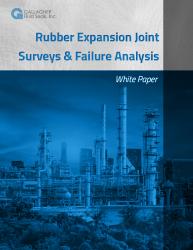
It will also discuss failure analysis of rubber expansion joints and some of the leading causes of joint failure.
Below is an except from the white paper, discussing failure analysis of rubber expansion joints, and what it can tell you about the overall health of your piping system.
Failure Analysis
There are perceptible warning signs when an expansion joint is failing:
- Arch inversion indicating a system vacuum that has exceeded the joint’s specified expansion value.
- Cracking at the base of the arch, which indicates the joint has been over-elongated and should be replaced with one of the proper length.
- Ply separation on the outside of the cover. This is an indication the joint has been subjected to excessive movement.
- Leakage due to over-expansion, mating flange surface issues, or poor installation practices, especially (but not limited to) bolt tightness.
- Ballooning of arch, which indicates excessive system pressure.

“For example, in general water service with a relatively low flow rate, ambient temperature, stable system pressure, and minimal movement, an expansion joint could theoretically last up to 20 years,” write Damdar and Cramb. “Other applications, such as flue gas desulphurization systems, pump highly abrasive slurry media at high flow rates, accelerating joint wear. Every application is different, so failed expansion joints should be removed and assessed for the root causes of failure.”
Typically, expansion joints fail from the inside, where flow conditions can negatively impact the entire assembly.
Of the joint’s three basic components, the tube is the most crucial, as it acts as a physical and chemical boundary between the body and media. If the tube is compromised, the body can be exposed to the media, causing a possible degradation.
This is why it is vital that any inspection of a failed expansion joint look at the condition of the tube. In abrasive applications, the media can wear through the tube and body of a joint to the point where only a minimal amount of pressure can lead the tube to leak or burst. In other cases, as seen in the image to the right, excessive temperatures may have caused the tube to harden. This in turn causes the tube to lose its resilience and crack under dynamic movement.
“Understanding the root causes of expansion joint failures can provide useful information about the systems in which they were installed, but it is preferable to prevent such failures in the first place,” Garlock’s Cramb and Damdar write. “The challenge is to develop and deploy a maintenance program to find the visible indicators of potential joint failures and take the necessary preventative action. Frequency of inspections will vary with application conditions. Critical path and high-risk systems may require fairly frequent inspection, whereas less critical ones can be inspected biannually or even annually.”
